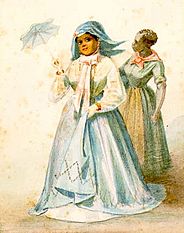Plaçage facts for kids
Plaçage was a system in French and Spanish slave colonies of North America (including the Caribbean) by which ethnic European men entered into civil unions with non-Europeans of African, Native American and mixed-race descent. The term comes from the French placer meaning "to place with".
The women were not legally recognized as wives but were known as placées; their relationships were recognized among the free people of color as mariages de la main gauche or left-handed marriages. Upon the death of her protector, the placée and her family could, on legal challenge, expect up to a third of the man's property. In some cases, they were given freedom if they were enslaved.
The system flourished throughout the French and Spanish colonial periods, reaching its zenith during the latter, between 1769 and 1803.
The plaçage system developed from the predominance of men among early colonial populations, who took women as consorts from Native Americans, free women of color and enslaved Africans. In this period there was a shortage of European women, as the colonies were dominated in the early day by male explorers and colonists. Given the harsh conditions in the colonies, persuading women to follow the men was not easy.
Plaçage was widely practiced in New Orleans, where planter society had created enough wealth to support the system. It also took place in the Latin-influenced cities of Natchez and Biloxi, Mississippi; Mobile, Alabama; St. Augustine and Pensacola, Florida; as well as Saint-Domingue (now the Republic of Haiti). Plaçage became associated with New Orleans as part of its cosmopolitan society.
See also
 In Spanish: Plaçage para niños
In Spanish: Plaçage para niños



